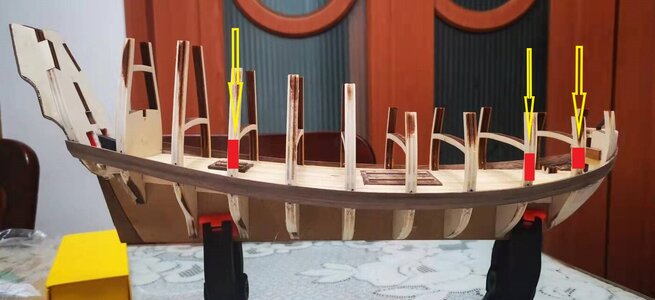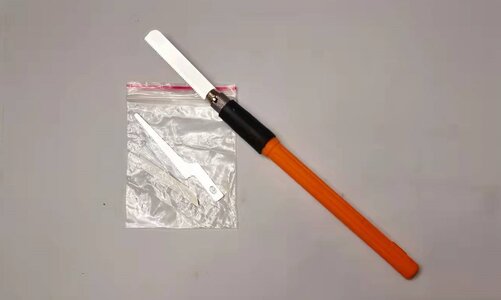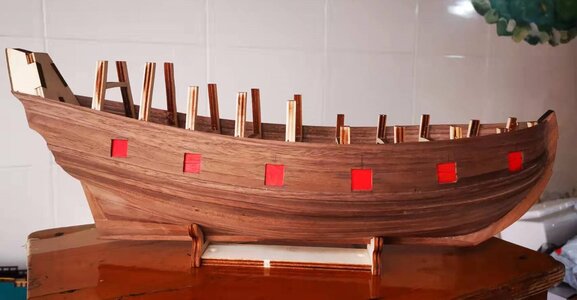- Joined
- Jan 9, 2020
- Messages
- 10,548
- Points
- 938

Hello Everyone
The agenda for today was simple. Glue the inserts behind the gunports #2, 3 and 8 and start cutting out gunports on the Port Side - sweet and simple.
Ha! Seven hours later and I have J-U-S-T (in the last rays of daylight) finished gluing the inserts behind gunports #2, 3 and 8. And when I say "finished", take that with the proverbial pinch of salt. I'll tell you why, just now.
Seven hours later and I have J-U-S-T (in the last rays of daylight) finished gluing the inserts behind gunports #2, 3 and 8. And when I say "finished", take that with the proverbial pinch of salt. I'll tell you why, just now.
Under no circumstances could I manage to cover the full area of the gunport with the bulkheads interfering. In the end, I realized there was no other option. Those bulkhead-sections had to go.

The bulkhead portions marked in red at Bulkheads #2, 3 and 8, had to be removed completely which means that the upper sections of those bulkheads are now literally "floating" with no support at the bottom. That is why I said you must take the word "finished" lightly, because as soon as the glue is dry on the red filler pieces, I have to start fabricating supports for those three bulkheads. As all three those frames carry the deck beams this is vital that they are properly anchored on the starboard side before I start any work on the port side, as I will have to do the same cut-aways on that side.

Luckily, when I ordered the WB from Hans, I also ordered this little saw with three different blades. If I didn't have this, I have no idea of how I would have sawn out or removed those portions.
In any case, this where I am this afternoon:

Tonight, I will try to brace those bulkheads and tomorrow I can hopefully start on the port side.
The agenda for today was simple. Glue the inserts behind the gunports #2, 3 and 8 and start cutting out gunports on the Port Side - sweet and simple.
Ha!
 Seven hours later and I have J-U-S-T (in the last rays of daylight) finished gluing the inserts behind gunports #2, 3 and 8. And when I say "finished", take that with the proverbial pinch of salt. I'll tell you why, just now.
Seven hours later and I have J-U-S-T (in the last rays of daylight) finished gluing the inserts behind gunports #2, 3 and 8. And when I say "finished", take that with the proverbial pinch of salt. I'll tell you why, just now.Under no circumstances could I manage to cover the full area of the gunport with the bulkheads interfering. In the end, I realized there was no other option. Those bulkhead-sections had to go.

The bulkhead portions marked in red at Bulkheads #2, 3 and 8, had to be removed completely which means that the upper sections of those bulkheads are now literally "floating" with no support at the bottom. That is why I said you must take the word "finished" lightly, because as soon as the glue is dry on the red filler pieces, I have to start fabricating supports for those three bulkheads. As all three those frames carry the deck beams this is vital that they are properly anchored on the starboard side before I start any work on the port side, as I will have to do the same cut-aways on that side.

Luckily, when I ordered the WB from Hans, I also ordered this little saw with three different blades. If I didn't have this, I have no idea of how I would have sawn out or removed those portions.
In any case, this where I am this afternoon:

Tonight, I will try to brace those bulkheads and tomorrow I can hopefully start on the port side.










